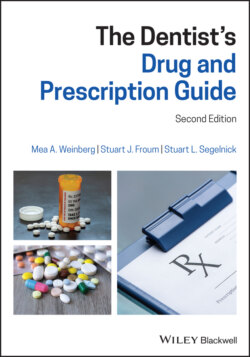Читать книгу The Dentist's Drug and Prescription Guide - Mea A. Weinberg - Страница 11
2 The Prescription and Drug Names 2.1 Parts of a Prescription
Оглавление1 Q. What are the different parts of a written prescription?
2 A.Heading:Prescriber's name, address, phone number, license number, Drug Enforcement Administration (DEA) number and NPI (national provider identifier) (the DEA number can also be located at the bottom of the prescription by the prescriber's signature)Patient's information (name, address, age, weight)Date of the order (must be written or it is not legal).Body:Rx symbolMedication prescribed (drug name, strength, and formulation) and quantity to be dispensedInstructions to the pharmacist. For example: Dispense 10 capsules.Closing:Signature (Sig): directions to the patientSignature of prescriberWhether or not substitution is permissibleNumber of refillsLabel (informs the pharmacist how to label the medication).
3 Q. What does “Rx” mean?
4 A. Rx is a symbol referring to “prescription.” Rx stands for the Latin word “recipe” or “take thou” or “take thus” or “to take.” Essentially, it is a command to take a specific compound.
5 Q. What does “Sig” mean?
6 A. Sig is an abbreviation for the Latin signatura, meaning “write,” “make” or “label.” These should always be written in English; however, prescribers sometimes use Latin abbreviations, e.g., “1 cap tid pc,” which the pharmacist translates into English as “take one capsule three times daily after meals.”
7 Q. Does the age of the patient need to be written on the prescription?
8 A. Yes. Generally, it is helpful to write in the age (in years) of the patient. For pediatric prescriptions, it is recommended to write in the age of the child if the patient is less than 12 years of age and the age in years and months if less than 5 years of age. Including the weight of the child is also helpful. For Schedule II drugs, it is mandatory to include the age of the patient on the prescription. The reason for writing the age of the patient is that in some cases dose adjustments may be needed.
9 Q. What is the NPI?
10 A. NPI stands for national provider identifier. It is an identification number given to healthcare providers by the CMS (Centers for Medicare and Medicaid Services). Healthcare providers must apply for an NPI number through an application process on the CMS website. Health practitioners need to have this number in order to receive reimbursement from insurance companies and to prescribe medicines.
11 Q. What does the label box at the bottom of the prescription mean?
12 A. Any information about the medication to be dispensed is provided on the label that is affixed to the drug container.
